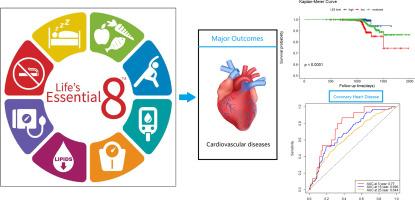Importance of Life’s Essential 8 in predicting short- and long-term incidence of cardiovascular disease: The atherosclerosis risk in communities study
IF 5.9
Q1 CARDIAC & CARDIOVASCULAR SYSTEMS
引用次数: 0
Abstract
Background
As is acknowledged that there is a strong negative association between Life’s Essential 8 (LE8) and the major adverse cardiovascular events (MACE). However, from the perspective of primary prevention of cardiovascular diseases (CVD), it is more valuable to discover the factors to predict the incidence of CVD. We intend to explore the predictive value of LE8 for the short-term and long-term incidence of CVD in the population without CVD at baseline.
Methods
Participants in the ARIC (Atherosclerosis Risk in Communities) study were studied. Logistic regression models estimated the relationship between LE8 and CVD, including coronary heart disease (CHD), atrial fibrillation (AF) and stroke. Cox proportional hazards regression models were employed to assess whether an increase in the LE8 score could reduce the short-term and long-term incidence of CVD.
Results
Among the 8083 participants studied at V2, 332 (4.1%) were diagnosed with CHD, 98 (1.8%) with stroke, and 24 (0.3%) with AF. LE8 was negatively associated with the prevalence of CHD, stroke, but without statistically significant association with AF. After adjusting for other cardiovascular-related risk factors, LE8 was still negatively associated with stroke (OR:0.959; 95%CI, 0.943-0.976; P<0.001). During the short-term follow-up, for each 1-point increase in the LE8 score, the risks of CHD, stroke, and AF decreased by 6.5%, 5.4%, and 5.1% respectively (the hazard ratio values were 0.935, 0.946, and 0.949). Whether LE8 was used as a continuous variable or a categorical variable, the higher the score, the lower the likelihood of developing CHD at the long-term follow-up. Using the ROC curve, the area under the curve (AUC) of LE8 for predicting the 5-year, 15-year, and 25-year incidence of CHD was 0.77, 0.696, and 0.644, respectively.
Conclusions
A higher LE8 score is consistently associated with a lower probability of the incidence of CHD during both short-term and long-term follow-up periods.

生命要素8在预测心血管疾病短期和长期发病率中的重要性:社区动脉粥样硬化风险研究
众所周知,生命必需8 (LE8)与主要心血管不良事件(MACE)之间存在强烈的负相关。然而,从心血管疾病一级预防的角度来看,发现预测心血管疾病发病率的因素更有价值。我们打算探讨LE8对基线时无CVD人群的短期和长期CVD发病率的预测价值。方法对社区动脉粥样硬化风险(ARIC)研究的参与者进行研究。Logistic回归模型估计LE8与CVD的关系,包括冠心病(CHD)、心房颤动(AF)和脑卒中。采用Cox比例风险回归模型评估LE8评分的升高是否能降低CVD的短期和长期发病率。结果在V2期研究的8083名参与者中,332名(4.1%)被诊断为冠心病,98名(1.8%)被诊断为卒中,24名(0.3%)被诊断为房颤。LE8与冠心病、卒中的患病率呈负相关,但与房颤的相关性无统计学意义。在校正其他心血管相关危险因素后,LE8仍与卒中呈负相关(OR:0.959; 95%CI: 0.943-0.976; P<0.001)。在短期随访中,LE8评分每升高1分,冠心病、脑卒中、房颤发生风险分别降低6.5%、5.4%、5.1%(风险比值分别为0.935、0.946、0.949)。无论是作为连续变量还是分类变量,在长期随访中,LE8得分越高,发生冠心病的可能性越低。ROC曲线显示,LE8预测5年、15年、25年冠心病发病率的曲线下面积(AUC)分别为0.77、0.696、0.644。结论在短期和长期随访期间,LE8评分越高,冠心病发生率越低。
本文章由计算机程序翻译,如有差异,请以英文原文为准。
求助全文
约1分钟内获得全文
求助全文
来源期刊

American journal of preventive cardiology
Cardiology and Cardiovascular Medicine
CiteScore
6.60
自引率
0.00%
发文量
0
审稿时长
76 days
 求助内容:
求助内容: 应助结果提醒方式:
应助结果提醒方式:


